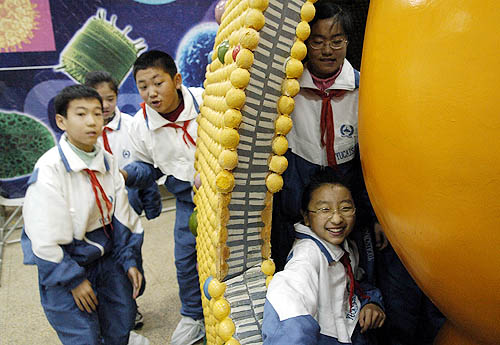|
 |
|
INNOVATIVE EDUCATION: Students of Yucai School in Beijing at their class in the Beijing Museum of Natural History (ZHANG XU) |
The draft of the National Outline for Medium- and Long-term Education Reform and Development (2010-20), which is to guide education reform during the next 10 years, was published on February 28, 2010, for a second round of public comment. It is divided into four sections: overall strategy, development tasks, system reform and guarantee provision.
The top two tasks in the next decade are to guarantee equal access to education while enhancing its quality, Education Minister Yuan Guiren said when introducing the outline. Yuan said priority should be given to the development of education and reform should be deepened through innovation.
Government education expenditure will be improved to 4 percent of gross domestic product (GDP) by 2012. In 2008, education expenditure accounted for 3.48 percent of China's GDP, said Ding Xuedong, Vice Minister of Finance. Ding said the target was ambitious because sectors such as agriculture, science and technology, health care and social security also needed funds.
The outline sets out specific goals. It says that, by 2010, one-year pre-school education enrolment will reach 95 percent, the gross high school enrolment ratio will reach 90 percent, illiteracy among young and middle-aged persons will be eliminated, the average education received by the major labor force will increase from 9.5 years to 11.2 years, and the percentage of the major labor force receiving post-secondary education will exceed 20 percent.
China should actively develop pre-school education, consolidate nine-year compulsory education, speed up the universalization of high-school education, boost vocational education, the outline says. It should comprehensively improve university education and accelerate the building of world-class universities. Continuous education should be stepped up. Greater education resources should be available in minority regions and special education supported.
More particularly, the outline says government, schools, families and society should work together to reduce course loads on primary and middle school students because excessive load is detrimental to students' physical and mental health.
Schools should not be ranked according to their students' admission ratios to higher levels of education, nor should scores in tests or competitions out of the mandatory curriculum serve as admission criteria.
The outline calls for balanced allocation of educational resources among schools and regions and between urban and rural areas. To narrow gaps between schools, an intra-county or district exchange system for teachers and school principals will be implemented, there should not be key schools or classes in the nine-year compulsory education system, and the quota for admission into top high or vocational schools should be reasonably allocated to junior middle schools in relevant regions.
Universities should improve research ability and the ability to serve society, and should optimize the setting up of majors. Regional distribution of universities should also be optimized. A special fund to support local higher education will be set up, and more support will be given to higher education in central and west China.
The outline also sets forward guidelines on reforming the examination and enrollment system. The examination and enrollment system should select students scientifically and fairly, and avoid "determining a student's fate by a single exam."
The outline calls for gradual removal of the existing practice of classifying schools by administrative rank and managing schools like government departments. Rights and responsibilities of governments and various types of schools should be clearly defined, and governments should reduce unnecessary administrative intervention in schools.
In financial matters, schools should be given greater freedom in distributing income within the school, employing and managing staff and in managing and using school properties and funds. High schools and vocational schools will also be given greater autonomy in finances, teaching methods, resource allocation, human resources, cooperative education and community service.
The outline encourages private investment in education and cooperation between enterprises and the school. It also pledges to remove policies discriminating against private schools.
The expansion of foreign exchanges and cooperation will be encouraged. The outline supports the establishment of schools and university laboratories and research centers jointly run by Chinese and foreign institutions. It allows for sending more Chinese to study abroad and attracting more foreign talent and students to China. The number of national scholarships offered to foreign students studying in China will be increased.
Work on the outline started in August 2008. Premier Wen Jiabao led the group in charge of putting together the draft, which was open for the first round of public feedback in January and February 2009. | 